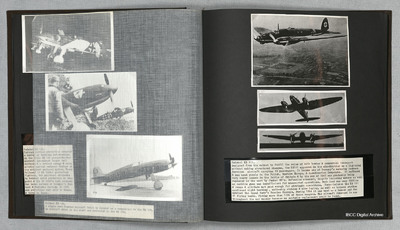Heinkel He 111
Title
Heinkel He 111
Description
Photo 1 is a port side flying view of an aircraft over a city.
Photo 2 is looking up at the underside of an aircraft.
Photo 3 is the nose of an aircraft on the ground.
Photo 2 is looking up at the underside of an aircraft.
Photo 3 is the nose of an aircraft on the ground.
Coverage
Language
Type
Format
Three b/w photographs on an album page
Publisher
Rights
This content is available under a CC BY-NC 4.0 International license (Creative Commons Attribution-NonCommercial 4.0). It has been published ‘as is’ and may contain inaccuracies or culturally inappropriate references that do not necessarily reflect the official policy or position of the University of Lincoln or the International Bomber Command Centre. For more information, visit https://creativecommons.org/licenses/by-nc/4.0/ and https://ibccdigitalarchive.lincoln.ac.uk/omeka/legal.
Identifier
PThomasAF20070014
Transcription
[Photograph]
[Photograph]
[Photograph]
Heinkel HE 111.
Designed from the outset to fulfil the roles of both bomber & commercial transport without making structural changes, the HE111 appeared in the mid-thirties as a Lightning Services aircraft carrying 10 passengers. It became one of Germany’s mainstay bombers & was used widely in the Polish, Western Europe, & Scandinavian Campaigns. It suffered very heavy losses in the Battle of Britain & by the end of 1940 was gradually being replaced in the west by Junker 88’s. Defensive armament, despite including cannon as well as machine guns was insufficient for unescorted operations. Bomb load was only 5500lbs & range & altitude not good enough for strategic operations. Nevertheless the HE 111 continued night bombing, anti-ship strikes & mine laying, as well as torpedo strikes against the Royal Navy’s Russian Convoys. During 1944 it was used as a launch pad for V1 flying bombs, firing more than 1200 of these weapons. The aircraft remained in use throughout the war mainly because no suitable replacement could be found.
[Photograph]
[Photograph]
Heinkel HE 111.
Designed from the outset to fulfil the roles of both bomber & commercial transport without making structural changes, the HE111 appeared in the mid-thirties as a Lightning Services aircraft carrying 10 passengers. It became one of Germany’s mainstay bombers & was used widely in the Polish, Western Europe, & Scandinavian Campaigns. It suffered very heavy losses in the Battle of Britain & by the end of 1940 was gradually being replaced in the west by Junker 88’s. Defensive armament, despite including cannon as well as machine guns was insufficient for unescorted operations. Bomb load was only 5500lbs & range & altitude not good enough for strategic operations. Nevertheless the HE 111 continued night bombing, anti-ship strikes & mine laying, as well as torpedo strikes against the Royal Navy’s Russian Convoys. During 1944 it was used as a launch pad for V1 flying bombs, firing more than 1200 of these weapons. The aircraft remained in use throughout the war mainly because no suitable replacement could be found.
Collection
Citation
“Heinkel He 111,” IBCC Digital Archive, accessed November 5, 2024, https://ibccdigitalarchive.lincoln.ac.uk/omeka/collections/document/23203.
Item Relations
This item has no relations.

